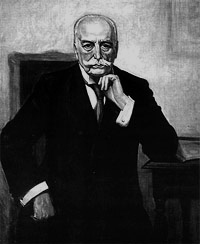Modern cuisine owes many of its practices to the great French chef Auguste Escoffier: he changed public dining in hotels and restaurants worldwide by creating systematized kitchens, serving dishes in a specific order instead of all at once and emphasizing the freshness and flavor of the ingredients used. We celebrate Escoffier’s culinary vision on the anniversary of his birth.
August Escoffier’s Early Days
Georges Auguste Escoffier was born on October 28, 1846, in the small village of Villeneuve-Loubet in the south of France. At age 13, Escoffier moved to Nice to take up an apprenticeship at his uncle’s restaurant.
At age 19, Escoffier traveled to Paris to begin training at the renowned restaurant Le Petit Moulin Rouge. His life changed dramatically when the Franco-Prussian war broke out in 1870 and he enlisted to fight. As a soldier and army chef, Escoffier learned about military organization and hierarchy. He also learned to can food. Both lessons would prove invaluable to his culinary contributions.
Sources in this Story
- Les Amis d’Escoffier Society of New York: An Escoffier Biography
- Les Dames d’Escoffier International: Auguste Escoffier
- World Culinary Institute: Auguste Escoffier 1846–1935
- The New York Times: Fund Raising Is Another Escoffier Dish
Escoffier’s Notable Accomplishments
When Escoffier returned from the war, he opened his own restaurant in Cannes. In 1884, he and his wife moved to Monte Carlo, where he met Cesar Ritz, with whom he would cofound the chain of Ritz Hotels. Escoffier’s career encompassed a variety of establishments, a marked departure from the traditional practices of high-end French chefs who generally worked for private employers. Although Escoffier would cook for royalty, famous artists and heads of state, his work was always for the public.
Escoffier’s medium for culinary advancement came mostly in hotel kitchens. It was at the Savoy Hotel in London (where he invented the dessert Peach Melba) and later at the Ritz Hotel in Paris that he most significantly influenced the way kitchens were run and French food was served.
He used his military background as inspiration for kitchen organization. Escoffier developed a kitchen brigade system, where each member worked at a single post, overseeing one essential aspect of the meal. In addition, Escoffier developed methods for canning and preserving sauces so that his customers could take his specialty items home.
Finally, Escoffier instilled in French cooks a sense of cleanliness by standardizing sanitation measures in the kitchen. Escoffier also cared deeply about preserving the nutrition of the foods he served and encouraged the use of seasonal ingredients and light sauces that would not overpower a dish. Escoffier simplified the complex haute cuisine menus typical of the 19th century and asserted that, “Because it is simplified on the surface, it does not lose its value. On the contrary, tastes are constantly being refined and cooking must be refined to satisfy them.”
Escoffier was dedicated to fostering education and culinary improvement and wrote several books that are still referenced by today’s chefs: “Le Guide Culinaire” (1903), “Le Livre des Menus” (1912) and “Ma Cuisine” (1934).
The Man and his Work
The Rest of the Story
In addition to cooking for the wealthiest and most famous individuals of his time, Escoffier maintained several philanthropic endeavors, including programs to feed the hungry and to assist retired chefs. For his culinary and charity work, Escoffier was named a Chevalier of the Legion d’Honneur in 1920 and Officer in 1928.
In order to fund the retirement home he developed for French cooks, Escoffier became well versed in entertaining. Escoffier’s Diners d’Epicure, which were held in several European cities from 1912 to 1914, may have been some of the first fundraising events, according to his great-grandson, Michel A. Escoffier.
Escoffier retired to Monte Carlo with his wife, Delphine, in 1921. When Escoffier was 89, Delphine passed away. A few days later, on February 12, 1935, Escoffier died as well.
This article was originally written by Isabel Cowles; it was updated October 24, 2017.











